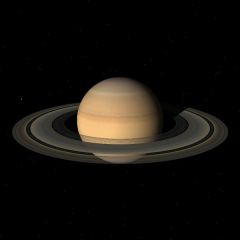Saturn
Saturn is the sixth planet from the Sun in the Solar System. It is the second largest planet in the Solar System, after Jupiter. Saturn is one of the four gas giant planets, along with Jupiter, Uranus, and Neptune.
Inside Saturn is probably a core of iron, nickel, silicon and oxygen compounds, surrounded by a deep layer of metallic hydrogen, then a layer of liquid hydrogen and liquid helium and finally, an outer gaseous layer.
Saturn has 146 moons with formal designations. The largest moon is Titan, which is larger in volume than the planet Mercury. Titan is the second-largest moon in the Solar System. The largest moon is Jupiter's moon, Ganymede. There is also a very large system of rings around Saturn. These rings are made of ice with smaller amounts of rocks and dust. Some people believe that the rings were caused from a moon impact or other event. Saturn is about 1,400,000,000 km (869,000,000 mi) from the Sun. Saturn takes 29.6 Earth years to revolve around the Sun.
Saturn was named after the Roman god Saturnus (called Kronos in Greek mythology). Saturn's symbol is ♄ which is the symbol of Saturnus' sickle.
Saturn in Orbiter
Saturn has been a part of Orbiter since the earliest version, Orbiter 2001, its orbit defined in the Saturn.cfg file. From Orbiter 2002 on, the orbit has been defined by the Vsop87.dll file.
See also
Saturn at Wikipedia.
Go to Addons for Saturn
References
| edit The Solar System | |
|---|---|
| Central star |
Sun (Sol) |
| Planets |
Mercury - Venus - Earth - Mars - Jupiter - Saturn - Uranus - Neptune |
| Natural satellites |
Moon - Phobos - Deimos - Io - Europa - Ganymede - Titan - more... |
| Add-ons |
Planets - Dwarf Planets - Small objects - Natural satellites - Alternative star systems |
